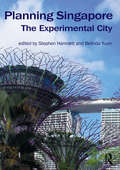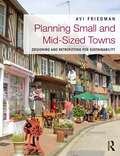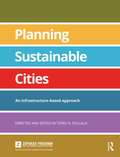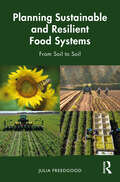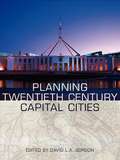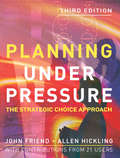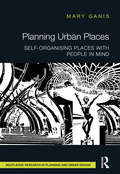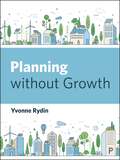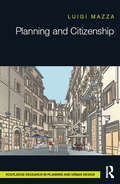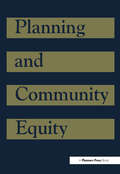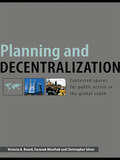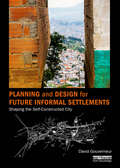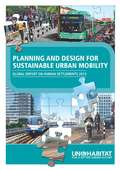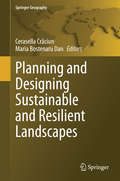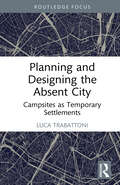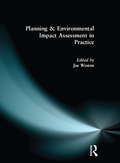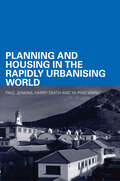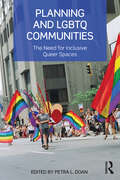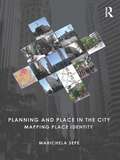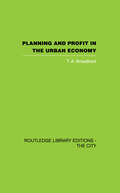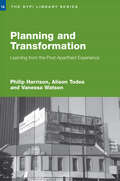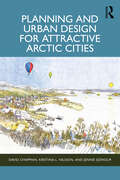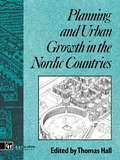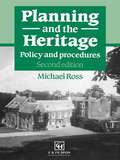- Table View
- List View
Planning Singapore: The Experimental City (Planning, History and Environment Series)
by Belinda Yuen Stephen HamnettTwo hundred years ago, Sir Stamford Raffles established the modern settlement of Singapore with the intent of seeing it become ‘a great commercial emporium and fulcrum’. But by the time independence was achieved in 1965, the city faced daunting problems of housing shortage, slums and high unemployment. Since then, Singapore has become one of the richest countries on earth, providing, in Sir Peter Hall’s words, ‘perhaps the most extraordinary case of economic development in the history of the world’. The story of Singapore’s remarkable achievements in the first half century after its independence is now widely known. In Planning Singapore: The Experimental City, Stephen Hamnett and Belinda Yuen have brought together a set of chapters on Singapore’s planning achievements, aspirations and challenges, which are united in their focus on what might happen next in the planning of the island-state. Chapters range over Singapore’s planning system, innovation and future economy, housing, biodiversity, water and waste, climate change, transport, and the potential transferability of Singapore’s planning knowledge. A key question is whether the planning approaches, which have served Singapore so well until now, will suffice to meet the emerging challenges of a changing global economy, demographic shifts, new technologies and the existential threat of climate change. Singapore as a global city is becoming more unequal and more diverse. This has the potential to weaken the social compact which has largely existed since independence and to undermine the social resilience undoubtedly needed to cope with the shocks and disruptions of the twenty-first century. The book concludes, however, that Singapore is better-placed than most to respond to the challenges which it will certainly face thanks to its outstanding systems of planning and implementation, a proven capacity to experiment and a highly developed ability to adapt quickly, purposefully and pragmatically to changing circumstances.
Planning Small and Mid-Sized Towns: Designing and Retrofitting for Sustainability
by Avi FriedmanSmall and mid-sized suburban towns house two-thirds of the world’s population and current modes of planning for these municipalities are facing challenges of both philosophy and form. Common approaches that have prevailed in past decades no longer sustain new demands and require innovative thinking. Rather than dismissing small and mid-sized towns as unattractive suburban sprawl, Planning Small and Mid-Sized Towns offers ideas and methods on how small isolated and edge towns can be designed and retooled into sustainable, affordable and adaptable communities. Coverage includes: the evolution of small towns mobility and connectivity neighborhood and sustainable dwelling design town centers and urban renewal economic sustainability and wealth generation, and more. With numerous case studies from North America and Europe and over 150 color photographs, maps, and illustrations, Planning Small and Mid-Sized Towns is a valuable, practical resource for professional planners and urban designers, as well as students in these disciplines.
Planning Sustainable Cities: An infrastructure-based approach
by Spiro N. PollalisPlanning Sustainable Cities: An infrastructure-based approach provides an analytical framework for urban sustainability, focusing on the services and performance of infrastructure systems. The book approaches infrastructure as a series of systems that function in synergy and are directly linked with urban planning. This method streamlines and guides the planning process, while still highlighting detail, each infrastructure system is decoded in four "system levels". The levels organize the processes, highlight connections between entities and decode the high-level planning and decision making process affecting infrastructure. For each system level strategic objectives of planning are determined. The objectives correspond to the five focus areas of the Zofnass program: Quality of life, Natural World, Climate and Risk, Resource Allocation, Leadership. Developed through the Zofnass Program at the Harvard Graduate School of Design, this approach integrates the key infrastructure systems of Energy, Landscape, Transportation, Waste, Water, Information and Food and explores their synergies through land use planning, engineering, economics and policy. The size and complexity of infrastructure systems means that multiple stakeholders facing their own challenges and agendas are involved in planning; this book creates a common, collaborative platform between public authorities, planners, and engineers. It is an essential resource for those seeking Envision Sustainability Professionals accreditation.
Planning Sustainable and Resilient Food Systems: From Soil to Soil
by Julia FreedgoodCovid-19 was a canary in a mine. It exposed the vulnerabilities of 21st-century food systems but did not create them. Since then, the world has faced a “polycrisis:” a cluster of weather-related crop failures, war-induced food and energy shortages, and import dilemmas with compounding effects. Going forward, we need to plan for more sustainable and resilient food systems that improve environmental outcomes and address economic disparities. But food systems planning is a relatively new discipline and guidance is scarce. This book fills that gap.Where most food systems planning has focused on urban issues, this book takes a holistic view to include rural communities and production agriculture whose stewardship of the earth is so critical to public and environmental health, as well as to ensuring a varied and abundant food supply. Its goal is to inform planning practices and follow-up actions for a wide range of audiences—from professional planners, planning commissions, and boards to conservation districts and Cooperative Extension to the on-the-ground change-makers working to strengthen America’s food and farming systems. Embracing the fact that the U.S. is highly diverse in its people, places, and politics, the book lifts up principles and successful examples to help communities develop strategies based on their unique assets and the needs and preferences of their people.
Planning Theory for Practitioners
by Michael BrooksThis book is recommended reading for planners preparing to take the AICP exam. In this new book, the author bridges the gap between theory and practice. The author describes an original approach-Feedback Strategy-that builds on the strengths of previous planning theories with one big difference: it not only acknowledges but welcomes politics-the bogeyman of real-world planning. Don't hold your nose or look the other way, the author advises planners, but use politics to your own advantage. The author admits that most of the time planning theory doesn't have much to do with planning practice. These ideas rooted in the planner's real world are different. This strategy employs everyday poltiical processes to advance planning, trusts planners' personal values and professional ethics, and depends on their ability to help clients articulate a vision. This volume will encourage not only veteran planners searching for a fresh approach, but also students and recent graduates dismayed by the gap between academic theory and actual practice.
Planning Twentieth Century Capital Cities (Planning, History and Environment Series)
by David GordonThe twentieth century witnessed an unprecedented increase in the number of capital cities worldwide – in 1900 there were only about forty, but by 2000 there were more than two hundred. And this, surely, is reason enough for a book devoted to the planning and development of capital cities in the twentieth century. However, the focus here is not only on recently created capitals. Indeed, the case studies which make up the core of the book show that, while very different, the development of London or Rome presents as great a challenge to planners and politicians as the design and building of Brasília or Chandigarh. Put simply, this book sets out to explore what makes capital cities different from other cities, why their planning is unique, and why there is such variety from one city to another. Sir Peter Hall’s ‘Seven Types of Capital City’ and Lawrence Vale’s ‘The Urban Design of Twentieth Century Capital Cities’ provide the setting for the fifteen case studies which follow – Paris, Moscow and St Petersburg, Helsinki, London, Tokyo, Washington, Canberra, Ottawa-Hull, Brasília, New Delhi, Berlin, Rome, Chandigarh, Brussels, New York. To bring the book to a close Peter Hall looks to the future of capital cities in the twenty-first century. For anyone with an interest in urban planning and design, architectural, planning and urban history, urban geography, or simply capital cities and why they are what they are, Planning Twentieth Century Capital Cities will be the key source book for a long time to come.
Planning Under Pressure
by John Friend Allen HicklingPlanning under Pressure offers managers, planners, consultants and students a comprehensive and authoritative guide to the Strategic Choice Approach, which has gradually been attracting worldwide recognition as a fresh, versatile and practical approach to collaborative decision-making under uncertainty. Starting from basic principles, the book uses helpful diagrams and clear explanations to demonstrate practical ways of approaching daunting decision problems; of devising possible ways forward; and of working effectively towards agreed courses of action. Along he way, decision makers are helped to cope with diverse sources of uncertainty – technical, political, managerial – in a strategic manner.In this extended third edition, the authors have added short contributions from 21 users from seven countries. These new contributors present lessons from their varied experiences in adapting the Strategic Choice Approach to guide decision-making and learning in settings ranging from the re-routing of a controversial city carnival procession to national policy for the management of nuclear waste.
Planning Urban Places: Self-Organising Places with People in Mind
by Mary GanisUrban change is often difficult because we are dealing with people’s elusive notions of place and perception, time and change. Urban design and planning in a changing urban context so that it remains relevant for people is elusive because the idea of place is embedded in memory and identity – but whose memory and whose identity? This book seeks to understand the urban change dynamic so that the planning of urban places aligns with the dynamic of people’s perception of place. Planning Urban Places examines the premise that building cities is a concrete business surrounded by a shifting context. It discusses the notion of urban design and placemaking from the perspective of place perception and cognitive psychology, place philosophy and human geography. It also considers network theory to help illustrate the self-organising paradigm of small word network theory for planning urban places.
Planning Without Growth
by Yvonne RydinMany planning systems are currently locked into growth-dependence, encouraging market-led development which can widen social inequalities and produce adverse environmental outcomes. This accessible book introduces students to the debates around growth and planning and sets out the solutions to promote genuinely sustainable communities. It includes: • a positive proposal for reform of the planning system; • focused discussions from the UK and Europe providing lessons for future planning; • analysis of the challenges of implementing reform. Covering chapters on cooperatives, community land trusts, local economic development and community assets and infrastructure, as well as commoning, it provides a roadmap for planning system reform with social justice and sustainability at its heart.
Planning and Citizenship
by Luigi MazzaPlanning is undergoing a period of profound change and risks losing meaning and authority by becoming merely a tool for financial speculation and generating capital. Planning and Citizenship seeks to rediscover planning’s technical and theoretical roots by reconstructing the memory of planning through the lens of the changing relationship between planning and citizenship. Tracing the historical relationship between planning and citizenship through a single thread, Luigi Mazza employs three ancient models – those of Hippodamus, Romulus, and Ancient China – to understand the foundations of spatial governance and citizenship. Paying particular attention to classic case studies of American cities, this book moves through the development of central planning theories by key thinkers like Geddes, Cerdà, Howard, Abercrombie and Lefebre. Analysing the role of government in promoting social citizenship and symbolic values through planning, Mazza takes into account the changing role of government in planning, including concepts of neoliberalism and the minimal State. Providing critical debate over the current role of spatial governance in planning and citizenship, Planning and Citizenship offers a unique historical analysis of a crucial topic in planning.
Planning and Community Equity: A Component of APA's Agenda for America's Communities
by American Institute of Certified PlannersThis thought-provoking book exhorts planners to establish community development programs that achieve greater social and economic equity. Some of the 13 chapters urge planners to incorporate community equity concerns into traditional planning areas such as transportation and economic development. Others challenge planners to get more involved in social areas such as urban education and community policing. Each chapter is authored by one or more professionals with expertise in the subject at hand. A helpful resource for planners who continue to tackle the problems of inequality.
Planning and Decentralization: Contested Spaces for Public Action in the Global South
by Faranak Miraftab Christopher Silver Victoria A. BeardThe first in-depth study of the impact of economic and political decentralization on planning practice in developing economies, this innovative volume, using original case study research by leading experts drawn from diverse fields of inquiry, from planning to urban studies, geography and economics, explores the dramatic transformation that decentralization implies in responsibilities of the local planning and governance structures. It examines a range of key issues, including: public and private finance local leadership and electoral issues planning in post-conflict societies. Offering unique insights into how planning has changed in specific countries, paying particular attention to South East Asian economies, India and South Africa, this excellent volume is an invaluable resource for researchers, graduate students and planners interested in urban planning in its international political and economic context.
Planning and Design for Future Informal Settlements: Shaping the Self-Constructed City
by David GouverneurThis is the first book to address future informal settlements at the global scale. It argues that to foster favourable conditions for the sustainable evolution of future informal cities, planners must consider the same issues that are paramount in formal urban developments, such as provision of: balanced land uses energy efficiency and mobility water management and food sufficiency governance and community participation productivity and competitiveness identity and sense of place Planning and Design for Future Informal Settlements makes a call for responsible action to address the urban challenges of the developing world, suggesting that the vitality of informality, coupled with spatial design and good management, can support the efficient use of resources in better places to live. The book analyses the strengths and weaknesses of informal urbanism and the challenges faced by the fast growing cities of the developing world. Through case studies, it demonstrates the contributions and limitations of different attempts to plan ahead for urban growth, from the creation of formal housing and urban infrastructures for self-built dwellings to the improvement of existing informal settlements. It provides a robust framework for planners and designers, policy-makers, NGOs and local governments working to improve living conditions in developing cities.
Planning and Design for Sustainable Urban Mobility: Global Report on Human Settlements 2013
by Un-HabitatUrban transport systems worldwide are faced by a multitude of challenges. Among the most visible of these are the traffic gridlocks experienced on city roads and highways all over the world. The prescribed solution to transport problems in most cities has thus been to build more infrastructures for cars, with a limited number of cities improving public transport systems in a sustainable manner. However, a number of challenges faced by urban transport systems – such as greenhouse gas emissions, noise and air pollution and road traffic accidents – do not necessarily get solved by the construction of new infrastructure. Planning and Design for Sustainable Urban Mobility argues that the development of sustainable urban transport systems requires a conceptual leap. The purpose of ‘transportation’ and ‘mobility’ is to gain access to destinations, activities, services and goods. Thus, access is the ultimate objective of transportation. As a result, urban planning and design should focus on how to bring people and places together, by creating cities that focus on accessibility, rather than simply increasing the length of urban transport infrastructure or increasing the movement of people or goods. Urban form and the functionality of the city are therefore a major focus of this report, which highlights the importance of integrated land-use and transport planning. This new report of the United Nations Human Settlements Programme (UN-Habitat), the world’s leading authority on urban issues, provides some thought-provoking insights and policy recommendations on how to plan and design sustainable urban mobility systems. The Global Report on Human Settlements is the most authoritative and up-to-date global assessment of human settlements conditions and trends. Preceding issues of the report have addressed such topics as Cities in a Globalizing World, The Challenge of Slums, Financing Urban Shelter, Enhancing Urban Safety and Security, Planning Sustainable Cities and Cities and Climate Change.
Planning and Designing Sustainable and Resilient Landscapes
by Cerasella Crăciun Maria Bostenaru DanThis book deals with planning issues in landscape architecture, which start at the evaluation of the existing fabric of society, its history and memory, approached and conserved through photography, film and scenographic installations, a way in which the archetypes can be investigated, be it industrial derelict sites or already green spaces and cultural landscapes. It provides approaches to intervention, through rehabilitation and upgrade, eventually in participative manner. To such evaluation and promotion a couple of disciplines can contribute such as history of art, geography and communication science and of course (landscape) architecture. The field of landscape architecture reunites points of view from such different disciplines with a view to an active approach a contemporary intervention or conservation. The book presents case studies from several European countries (Romania, Germany, Austria, Italy, Portugal) mostly for large landscape in the outskirts of the cities and in the parks.
Planning and Designing the Absent City: Campsites as Temporary Settlements
by Luca TrabattoniThis book concerns the study of open-air accommodation facilities. The market evolutions allow us to look at these structures as temporary settlements characterised by a low-density dwelling and a close connection with natural elements and the landscape.This new and different point of view is sustained by the tendency of outdoor tourism to go in the direction of temporary villages, and this tendency is directly related to "time" and "landscape". The landscape is the reason why the campsite is settled. The time is linked to the holiday season timing. Today, both are greatly influenced by the introduction of the "Maxi-Caravan". This removable living unit can be placed on the empty pitch, occupying the landscape without ruining the soil. By the settlement of Maxi-Caravans, the campsite is transformed from an empty landscape with tents to a temporary settlement, whose timing is divided between the seasonal timing of the campsite and the "timing" of the product, and whose landscape is organised by the relation with the prevalent landscape and the internal one. The book's core defines the outdoor facility structure, using Italy as the main case study. To identify design strategies, the book analyses temporary settlement examples (quick time) and projects from historic outdoor tourism (medium time). Finally, the last chapter reflects on open-air accommodation facilities by showing their applicability in the different contexts of the refugee camps (long time).The aim of this research is to enhance the theme of open-air accommodation facilities, highlighting the need to equalise the study of temporary settlements with that of permanent settlements. It will be of interest to researchers and students of planning, landscape and tourism.
Planning and Environmental Impact Assessment in Practice
by Joe WestonEnvironmental Impact Assessment (EIA) is a fast-growing field of land-use planning affecting many disciplines. At present, UK Government legislation requires EIA for certain types of development. Subject to a further new European directive, an EIA will be required for all policies, plans and programmes. Planning and Environmental Impact Assessment in Practice provides a practical introduction to the subject and relates the theory to the practice through extensive use of case studies. Edited by Joe Weston, the book draws on contributions from a number of practising experts in the field and covers topics such as: assessing the need for EIAs; the environmental team; scoping and public participation; internal and external consultation; local lobbying; local authority review and decision-making; public enquiries; monitoring the impacts; pollution control; and the lessons to be learned. Planning and Environmental Impact Assessment in Practice provides a practical introduction to EIA for final year undergraduate and postgraduate MSc courses in planning, geography, civil engineering, building and estate management, and development.
Planning and Housing in the Rapidly Urbanising World (Housing, Planning and Design Series)
by Harry Smith Paul Jenkins Ya Ping WangWritten specifically as a teaching text and authored by a team of leading academics in the field, this is the first book to bring together the key issues of rapid urbanisation with approaches to planning and housing. Outlining and explaining core concepts from ‘informal settlements’ to ‘sustainability’, it focuses on the rapid urbanization of developing countries with case studies from Latin America, Asia and Sub-Saharan Africa. The impact of rapid urbanization and associated globalization on land-use and housing is described and analyzed with reference to the particular issues of poverty, health and the environment of these areas. Providing an accessible introduction to the key issues as well as enhancing current theoretical debates and exploring practical applications, this book is an essential resource for students and researchers in this area.
Planning and LGBTQ Communities: The Need for Inclusive Queer Spaces
by Petra L. DoanAlthough the last decade has seen steady progress towards wider acceptance of lesbian, gay, bisexual, transgendered, and queer (LGBTQ) individuals, LGBTQ residential and commercial areas have come under increasing pressure from gentrification and redevelopment initiatives. As a result many of these neighborhoods are losing their special character as safe havens for sexual and gender minorities. Urban planners and municipal officials have sometimes ignored the transformation of these neighborhoods and at other times been complicit in these changes. Planning and LGBTQ Communities brings together experienced planners, administrators, and researchers in the fields of planning and geography to reflect on the evolution of urban neighborhoods in which LGBTQ populations live, work, and play. The authors examine a variety of LGBTQ residential and commercial areas to highlight policy and planning links to the development of these neighborhoods. Each chapter explores a particular urban context and asks how the field of planning has enabled, facilitated, and/or neglected the specialized and diverse needs of the LGBTQ population. A central theme of this book is that urban planners need to think "beyond queer space" because LGBTQ populations are more diverse and dispersed than the white gay male populations that created many of the most visible gayborhoods. The authors provide practical guidance for cities and citizens seeking to strengthen neighborhoods that have an explicit LGBTQ focus as well as other areas that are LGBTQ-friendly. They also encourage broader awareness of the needs of this marginalized population and the need to establish more formal linkages between municipal government and a range of LGBTQ groups. Planning and LGBTQ Communities also adds useful material for graduate level courses in planning theory, urban and regional theory, planning for multicultural cities, urban geography, and geographies of gender and sexuality.
Planning and Place in the City: Mapping Place Identity
by Marichela SepeUnder the influence of globalization, the centres of many cities in the industrialised world are losing their place identity, the set of cultural markers that define a city’s uniqueness and make it instantly recognisable. A key task for planners and residents, working together, is to preserve that unique sense of place without making the city a parody of itself. In Planning and Place in the City, Marichela Sepe explores the preservation, reconstruction and enhancement of cultural heritage and place identity. She outlines the history of the concept of placemaking, and sets out the range of different methods of analysis and assessment that are used to help pin down the nature of place identity. This book also uses the author's own survey-based method called PlaceMaker to detect elements that do not feature in traditional mapping and identifies appropriate planning interventions. Case studies investigate cities in Europe, North America and Asia, which demonstrate how surveys and interviews can be used to draw up an analytical map of place identity. This investigative work is a crucial step in identifying cultural elements which will influence what planning decisions should be taken in the future. The maps aim to establish a dialogue with local residents and support planners and administrators in making sustainable changes. The case studies are amply illustrated with survey data sheets, photos, and coloured maps. Innovative and broad-based, Planning and Place in the City lays out an approach to the identification and preservation of place and cultural heritage suitable for students, academics and professionals alike.
Planning and Profit in the Urban Economy
by T.A. BroadbentFirst Published in 2006. This text tries to answer some of the questions posed in the introduction to the British edition of 'After the Planners'- what is the relationship between government and industry and what is the role of planning within his relationship.
Planning and Transformation: Learning from the Post-Apartheid Experience (RTPI Library Series)
by Vanessa Watson Alison Todes Philip HarrisonPlanning and Transformation provides a comprehensive view of planning under political transition in South Africa, offering an accessible resource for both students and researchers in an international and a local audience. In the years after the 1994 transition to democracy in South Africa, planners believed they would be able to successfully promote a vision of integrated, equitable and sustainable cities, and counter the spatial distortions created by apartheid. This book covers the experience of the planning community, the extent to which their aims were achieved, and the hindering factors. Although some of the factors affecting planning have been context-specific, the nature of South Africa’s transition and its relationship to global dynamics have meant that many of the issues confronting planners in other parts of the world are echoed here. Issues of governance, integration, market competitiveness, sustainability, democracy and values are significant, and the particular nature of the South African experience lends new insights to thinking on these questions, exploring the possibilities of achievement in the planning field.
Planning and Urban Design for Attractive Arctic Cities
by David Chapman Kristina L Nilsson Jennie SjöholmThis book takes a deep dive into the design and planning, and unique challenges of settlements in the European Arctic. Attractive Arctic Cities require job opportunities, good societal and commercial services, and importantly, high-quality built environments in order to thrive. The cities of the European Arctic are generally small and sit in sparsely populated regions, with large travel times between places, making them uniquely challenging from a planning and design perspective. The chapters detail the planning process and place-shaping in the Arctic. Emphasis is placed on the importance of urban design, microclimate, cultural heritage, and movement and transport. The objective is to provide an overview for students and practitioners of architecture, urban design and town planning, of the design and planning of Arctic settlements in the European Arctic (Finland, Norway, Sweden) as well as in North America, Canada, Russia, Iceland, Greenland, and China.
Planning and Urban Growth in Nordic Countries (Planning, History and Environment Series)
by Thomas HallPlanning and Urban Growth in Nordic Countries examines urban development and planning in Denmark, Finland, Norway and Sweden. Emphasis is on the period from the mid-nineteenth century to the present day, and the authors of each 'country-study' look at their own national developments against the background of those in other Nordic countries well as the rest of Europe and the USA.
Planning and the Heritage: Policy and procedures
by Michael RossThis is a clear guide to heritage legislation in the UK. It is set out in plain, non-legal language and will guide the planner, developer, architect or conservationist through the legislation, explaining the policy and procedures which govern the protection of historic buildings as well as providing clear explanations of the issues involved, including listing, planning appeals and grants.
